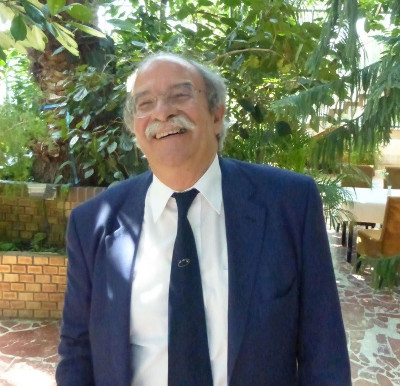 John Seiradakis (Photo courtesy of Richard Wielebinski)
John Seiradakis (Photo courtesy of Richard Wielebinski)
John Hugh Seiradakis
Contributed by Richard Wielebinski
John Seiradakis was born in Chania, Crete (Greece) 5 March 1948. He completed his undergraduate studies in the University of Athens with a degree in physics in 1971. For his postgraduate studies John moved to the Victoria University in Manchester, obtaining the M.Sc. degree in 1973, completing the Ph.D. degree in 1975 with a topic on pulsar searches. In this project John discovered 13 new pulsars.
John moved to the Max-Planck-Institute in Bonn in 1975, joining the pulsar research group. He became involved in studies of pulsar microstructure. He was also involved in early polarization observations of the Galactic Centre. In 1978 John moved to the University of Hamburg working on the topic of Galactic HI and HI haloes around galaxies. The next move in his career was to the University of California in San Diego in 1982, working on low frequency emission of the Crab pulsar. John returned in 1984 to the MPI für Radioastronomie in Bonn working again on pulsars. This return was as Alexander von Humbold fellow. The return to his native Greece came in 1986 with the appointment in the Physics Faculty of the Aristoteles-University in Thessaloniki. As the Professor in the Physics Faculty he supervised students as well as continuing his pulsar research and building up co-operations in European networks. Also optical observations became his interest. John became involved in the Greek National Committee for Astronomy and in the Hellenic Astronomical Society. He served as President 1998-2002.
In December 2005 the EU Descartes Prize was awarded to the neutron star research network PULSE which was co-founded by John.
In more recent times John participated in the Antikythera Mechanism Research Group, where he organised the scientific studies of this antique mechanical computer. This device was recovered by sponge divers from a sunken Roman ship near the island of Antikythera. Using powerful X-ray apparatus it could be shown to be a most advanced ancient astronomical (mechanical) computer. This research led to more than 200 public lectures around the world showing the advanced state of astronomical and mathematical research in ancient Greece. (see Seiradakis & Edmunds, Nature Astronomy, volume 2, pp35-42, 2018).
John Seiradakis died on 3 May 2020, in Thessaloniki. He was a most pleasant person, very generous, involved all his life in helping students and fellow staff members.
Modified on Wednesday, 29-Jul-2020 11:39:32 EDT by Ellen Bouton, Archivist (Questions or feedback)
|
![[IAU logo]](iau_wb_thumb.jpg)
![[URSI logo]](URSI-logo-thumb.jpg)
![[Karl Jansky at his antenna]](jansky_photo_02_thumb.jpg)
![[Reber's Wheaton antenna]](Reber_Telescope_Wheaton_thumb.jpg)
![[Dover Heights]](Dover_Heights_02_thumb.jpg)
![[4C telescope]](GB61-195_4C_telescope_thumb.jpg)
![[Ewen and horn antenna]](ewen_horn1s.jpg)
![[Dwingeloo, 1956]](Dwingeloo-1956-thumb.jpg)
![[Jocelyn Bell Burnell and Cambridge antenna used in pulsar discovery]](burnell2_thumb.jpg)
![[Lovell Telescope at Jodrell Bank]](site_1594_0001-500-334-20180316163019-thumb150.jpg)
![[Wilson, Penzias, and Bell Labs horn antenna]](wilson-penzias-horn_thumb.jpg)
![[6-m Millimeter Radio Telescope in Mitaka, Japan]](6m-thumb.jpg)

